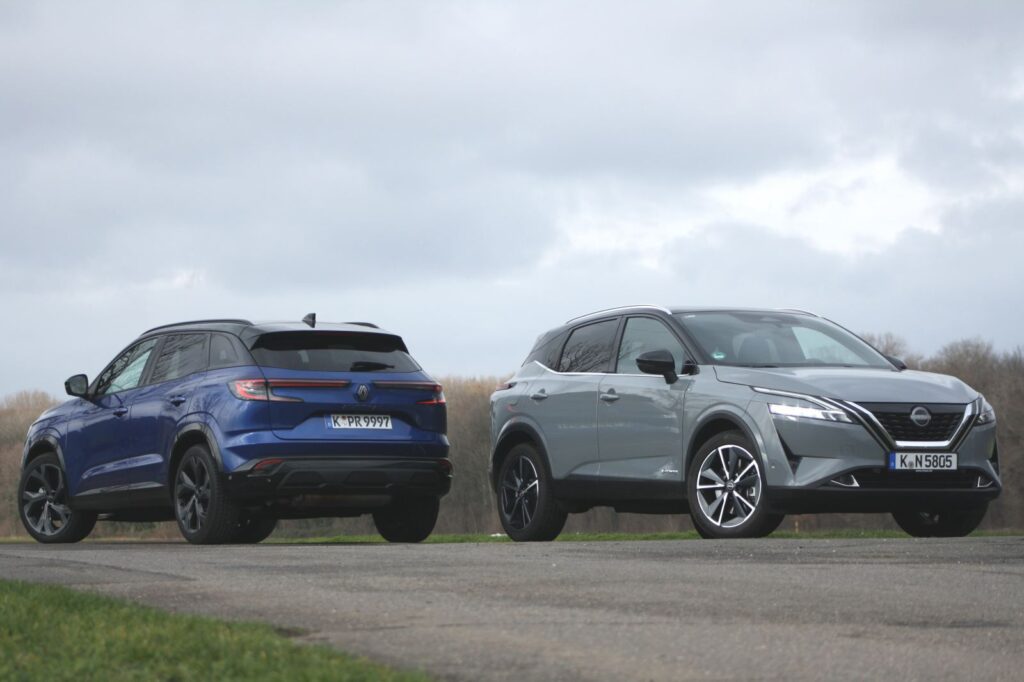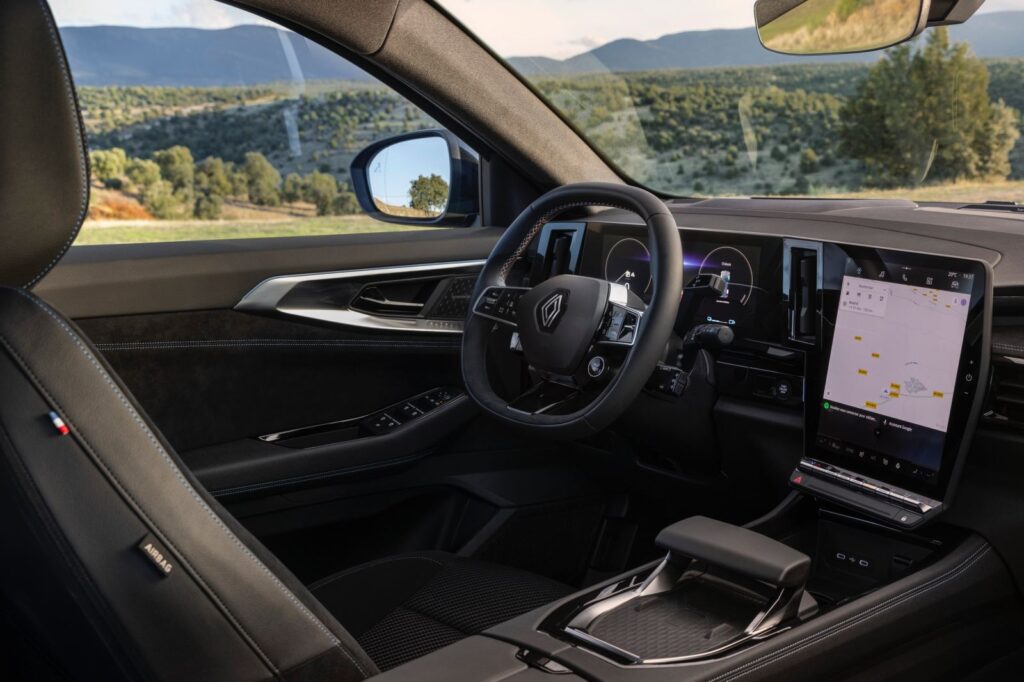Comparing technology clones is often boring. Cars from different manufacturers are too similar. In the case of Nissan's Qashqai and the platform twin Renault Austral, however, there are many differences.
One base, two worlds
The SUV duo Austral / Quashai shares the technical Platform, but Renault and Nissan took care to work out differences. We looked at both in comparison.

The Qashqai At 4,43 meters, it is slightly smaller than the Austral, which is 8 centimeters longer. When placed side by side, it falls size difference hardly noticeable, but the clearly different designs are much more obvious. If character lines in the sheet metal, lights, side windows, the design of the face and butt - here are two cars together, which one as competition models different manufacturers perceives. The Qashqai may appear a touch more elegant, streamlined. The Austral, on the other hand, is enhanced by detail-obsessed and animated lights. Very trendy Renault relies on LEDs instead of chrome decoration, the Nissan is even more extensive. Rather than resembling the Qashqai, the Austral design forges a family bond with the new electric Megane. Not as a Nissan clone, but as a confident member of a future-oriented Renault family Frenchman hence.

Also inside. In both cases, the workplace was set up digitally in a contemporary way, but at the same time care was taken to ensure that each had its own screen, operating and material worlds to stage. The workplace in the Renault works more progressive and something more valuable, which is a track in the Nissan more classic and less surprising. In the Qashqai, for example, the gear selector is still in the center console, while in the Austral it has been designed as a steering column stalk, which in turn gives more freedom when driving Design of the center console, which Renault has designed to be both stylish and functional. There are more buttons in the Qashqai cockpit, while the French have a particularly large one that is inclined towards the driver, based on the Tesla model Touchscreen at the center of the operating and infotainment solution, which also Google builds up. Nissan, on the other hand, swears by its own digital user interface, which seems a bit outdated, but poses fewer puzzles. The bottom line is that both cars are contemporary and #clear and, thanks to many options available in the test specimens, also comfortably furnished. Remarkable from the driver's point of view are the pleasingly narrow A-pillars in both test subjects, while the wide C-pillars in both cases field of view severely restrict backwards. Also in the Austral, which, in contrast to the Qashqai, even has a third window in the flanks, which, however, is too small from the inside perspective to allow a generous view to the rear.
Here as there it is about five-door with good space in front and behind. If you invest in equipment, they open tailgates each electric. Thanks to intermediate inserts, both models are sill and trunk floor at the same height. Is there enough space in the Luggage compartment not, the intermediate decks can be lowered, the backrests can be folded down in a classic way. To do this, buttons in the backrest are pressed on the Nissan, while on the Austral there are levers in the side walls for remote unlocking. It is also different space yield Sea manufacturer's instructions: The Austral can load 500 to 1.525 liters, in the Nissan it is 479 to 1.415 liters in the #e-Power version.

Speaking of e-power: The Power Type makes perhaps the biggest difference in this comparison. While the Austral started out as a classic petrol engine with a small mild hybrid electric boost, the Qashqai already drives like an electric car. Debt is developed by Nissan, serial hybrid system e-Power, which combines a 1,5-litre petrol engine with an electric motor. The latter drives the Qashqai with its 140 kW/190 hp, while the Combustion engines as an on-board power plant Power generation acts. And typically for a Stromer, the Qashqai reacts to the courageous gas command with commitment and initially silently. In Austral, on the other hand, the Turbo petrol engine and the continuously variable transmission initially for a moment of commemoration and something growling combustion engine noise. The Austral conveys a more classic feel driving experience, while the Qashqai behaves somewhat idiosyncratically. If you want performance here, the petrol engine has to generate electricity. The actual drive initially puts in a lot of noise, but demands more Electricity as the little one Battery can deliver, sounds clearly perceptible in the background at a constant speed level of the four cylinders a. Those who are not in a hurry will certainly like the e-power drive because of its rather quiet, linear and even power output. High speed is not so much for him, because you want to be faster on the Autobahn on the road, the maximum 170 km / h driving Qashqai is loud and thirsty. It seems to be the better choice, especially in urban terrain, because it is faster to start, and thanks to the One Pedal Drive mode, you rarely have to brake. The Suspension the Nissan was also less bumpy, making it the more comfortable car. Who more often with pace on the Autobahn wants to drive on the road, will be with the tighter tuned Austral with classic gasoline probably befriend more. Despite the lavish 116 kW/158 hp, you will be more of a fellow swimmer than a left-lane lion with a maximum speed of 174 km/h. We still burned 7,8 liters of petrol with the Austral. At the Qashqai, the to more Efficiency educates, it was 6,0 liters.

By the way, anyone who opts for a mild hybrid petrol engine does not have to decide on the series, because it is offered for both Austral and Qashqai. The e-power drive tested here, on the other hand, remains a Nissan solution. The French alternatively offer the Austral with their own full hybrid system on, the one three cylinderspetrol engine (96 kW/131 hp) combined with an electric motor (50 kW/68 hp), which together provide 147 kW/200 hp. In this variant, the combustion engine remains the main power source, but the electric motor allows purely electric driving over shorter distances. Even with them Engines both partners therefore offer significantly different options. The prices differ only slightly. The Austral costs around 36.000 euros as a mild hybrid with automatic transmission, and the Qashqai costs 500 euros more. Should it be the full hybrid, the Frenchman starts at around 44.000 euros, while the Nissan counterpart e-Power is available from 41.360 euros. In addition, both brands offer different but essentially similar products equipment levels at. Who in both cases the expensive hybrid drives with full equipment combined, Nissan ends up at around 49.500 euros, the Austral is just over 52.000 euros.
Technical data:
Nissan Qashqai e-Power
Five-door, five-seat compact class SUV; Length: 4,43 meters, width: 1,84 meters (with exterior mirrors: 2,08 meters), height: 1,63 meters, wheelbase: 2,67 meters, trunk volume: 479 - 1.415 liters
Hybrid drive: 1,5-litre three-cylinder petrol engine; 116 kW/158 hp and 250 Nm, electric motor; 140 kW/190 hp and 330 Nm; continuously variable transmission, front-wheel drive, 0-100 km/h: 7,9 sec., Vmax: 170 km/h, standard consumption (WLTP): 5,3 - 5,4 liters/100 kilometers, test consumption: 6,0 liters, CO2 -Emission: 120 - 122 g/km, emission standard: Euro 6d
Price: from € 41.360
Renault Austral Mild Hybrid 160 Automatic
Five-door, five-seat compact SUV; Length: 4,51 meters, width: 1,83 meters, height: 1,62 meters, wheelbase: 2,67 meters, trunk volume: 500 - 1.525 liters
1,3 liter turbo petrol engine with four cylinders, 12 volt electrical system with starter motor, 116 kW/158 hp, max. torque 270 Nm at 1.800 rpm, front-wheel drive, CVT automatic transmission, Vmax: 174 km/h, 0- 100 km/h: 9,7 seconds. Standard fuel consumption (WLTP): 6,3 - 6,2 liters/100 kilometers, CO2 emissions: 142 - 141 g/km, emission standard: Euro 6 d-Full
Price: from € 35.950





